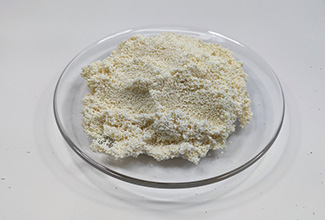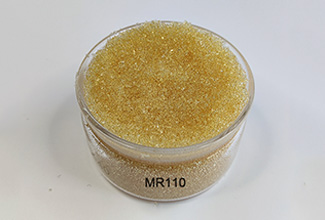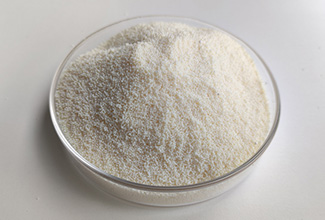Applications of Ion Exchange Resins in the Nuclear Industry
Ion exchange resins are a class of high-molecular-weight polymers with a network structure, containing active groups capable of exchanging ions with those in a solution. This unique property enables them to play a critical role in numerous industrial processes, such as water treatment and chemical separation and purification, providing efficient solutions for precise separation and purification of substances.
The nuclear industry is an important component of global energy production, providing humanity with a significant amount of clean energy. It also holds irreplaceable strategic significance in terms of national security and serves as a key indicator of a nation's scientific and technological strength and overall national power.
This paper aims to thoroughly explore the critical applications of ion exchange resins in the nuclear industry, highlighting their indispensable role in nuclear fuel processing, nuclear power plant operations, and other related processes.
1. Main Applications of Ion Exchange Resins in the Nuclear Industry
1.1 Extraction and Purification of Nuclear Fuel (Uranium)
Uranium exists in multiple isotopes, primarily including U-234, U-235, and U-238. In nuclear reactions, U-235 is the fissile isotope that can undergo fission when bombarded by thermal neutrons, releasing enormous energy. However, the natural uranium contains only about 0.7% U-235, far below the requirements for nuclear reactors and nuclear weapons. Therefore, enrichment processes are necessary to increase its concentration.
Extracting uranium from ore, wastewater, or leachate poses numerous challenges. Uranium in ore is often accompanied by various impurities and has a low concentration, making direct separation difficult; uranium concentrations in wastewater are typically extremely low, and the presence of numerous other ions further complicates extraction; leachate has a complex composition and poor stability, also posing significant obstacles to uranium extraction.
Ion exchange resins play a crucial role in the extraction and purification of uranium:
Achieving separation and concentration of uranium: Ion exchange resins can selectively adsorb uranium ions from solutions, separating them from complex systems. Through elution and other operations, uranium ions are concentrated in the eluent, increasing their concentration and laying the foundation for subsequent processing.
Removing impurities (such as thorium and plutonium): Resins exhibit high selectivity for uranium ions while having weak adsorption capacity for impurity ions like thorium and plutonium, enabling effective removal of these impurities and improving the purity of uranium products.
Producing high-purity uranium: Through ion exchange resin processing, low-enriched uranium for nuclear fuel and weapons-grade high-enriched uranium can be produced. Low-enriched uranium typically contains 3%–5% U-235 and is suitable for nuclear reactors such as nuclear power plants; high-enriched uranium contains over 90% U-235 and is primarily used in special fields such as nuclear weapons.
1.2 Nuclear Power Plant Operations
In water treatment systems, ion exchange resins play a crucial role:
Primary and secondary loop water purification: Primary loop water comes into direct contact with nuclear fuel, while secondary loop water is used for heat transfer. Ion exchange resins remove various ionic impurities from the water, preventing corrosion and scaling, and ensuring the normal operation of the loops.
Condensate polishing: Condensate is the byproduct of steam after it has done work in the turbine, and may contain trace amounts of ionic contaminants. Through ion exchange resin treatment, condensate can be purified to a high purity level and reused in the boiler cycle.
Applications in Critical Systems:
Chemical and Volume Control System (CVCS): This system maintains the chemical properties and volume stability of the primary loop. Ion exchange resins are used in this system to remove fission products and corrosion byproducts from the water, maintaining its purity.
Boron recovery and reuse: Boron is used in nuclear power plants to control the rate of nuclear reactions. Ion exchange resins can adsorb and recover boron ions from boron-containing water, enabling the recycling of boron and reducing costs.
Spent fuel cooling and waste liquid treatment: Spent fuel has high radioactivity and generates large amounts of waste liquid during cooling. Ion exchange resins can remove radioactive ions from the waste liquid, reducing its radioactive hazards and facilitating subsequent treatment.
Ion exchange resins are crucial for maintaining reactor efficiency and safety. They effectively control water quality, reduce corrosion and scaling damage to equipment, and ensure normal reactor operation. Additionally, by removing radioactive substances and other harmful materials, they reduce the risk of accidents, safeguarding personnel and environmental safety.
2. Advantages of ion exchange resins in nuclear applications
- High selectivity for target ions (e.g., uranium, boron): The active groups of ion exchange resins can form specific bonds with target ions, enabling precise adsorption of target ions in complex systems, thereby improving separation efficiency and purity.
- Capable of operating under extreme conditions (radiation resistance, thermal stability): Nuclear industrial environments often involve strong radiation and high temperatures. Ion exchange resins exhibit excellent radiation resistance and thermal stability, maintaining structural and performance stability under such conditions to ensure normal operation.
- Cost-effective compared to alternative separation technologies: The preparation and usage costs of ion exchange resins are relatively low, and their excellent regenerative properties allow for repeated reuse, reducing long-term operational costs. This provides significant economic advantages in large-scale nuclear industrial applications.
- Helps reduce nuclear waste and enhance environmental safety: Through efficient separation and purification, ion exchange resins reduce the volume of nuclear waste generated while removing or concentrating harmful substances in nuclear waste, thereby lowering the risk of environmental contamination from nuclear waste and improving environmental safety in the nuclear industry.
3.Summary
In summary, ion exchange resins play an essential role in nuclear fuel processing and nuclear power plant operations. During nuclear fuel extraction and purification, they achieve efficient separation, concentration, and purification of uranium, providing critical support for nuclear fuel production; in nuclear power plant operations, they ensure the normal operation of water systems, maintaining reactor efficiency and safety.
Ion exchange resins have made significant contributions to the efficiency, safety, and sustainable development of the nuclear industry. They not only enhance the utilization efficiency of nuclear fuel and the operational stability of nuclear power plants but also play a positive role in reducing nuclear waste and mitigating environmental risks, making them indispensable in the development of the nuclear industry.
-
 DA860 Acrylic Anion Exchange Adsorbent ResinAppearance: Milky white to Light yellow opaque sphericalIonic form:Cl-Volume complete exchange capacity(mmol/ml):≥1.6
DA860 Acrylic Anion Exchange Adsorbent ResinAppearance: Milky white to Light yellow opaque sphericalIonic form:Cl-Volume complete exchange capacity(mmol/ml):≥1.6 -
 MR110 Mixed Bed Ion Exchange ResinAppearance: Yellow-brown spherical particles.Ionic form:H+/OH-Volume complete exchange capacity(mmol/ml):≥0.6
MR110 Mixed Bed Ion Exchange ResinAppearance: Yellow-brown spherical particles.Ionic form:H+/OH-Volume complete exchange capacity(mmol/ml):≥0.6 -
 D201 Macroporous Strong Base Anion Exchange ResinAppearance: Milky white or light gray opaque spherical particles.Ionic form:Cl-Volume complete exchange capacity(mmol/ml):≥1.2
D201 Macroporous Strong Base Anion Exchange ResinAppearance: Milky white or light gray opaque spherical particles.Ionic form:Cl-Volume complete exchange capacity(mmol/ml):≥1.2

